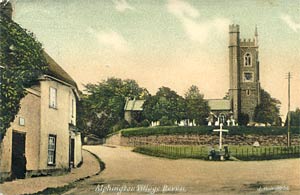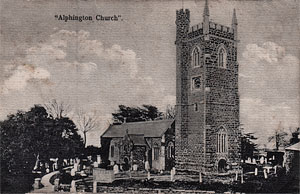
St Michael's and All Angel's - Alphington
Page updated 23 July 2008
The first church in Alphington dedicated to St Michael dates back at least 1,200 years. The present church dates from 1477, and was paid for by the Courtenay's and local parishioners at a cost of £700. Church House was built to house the workers building the church and therefore pre-dates the present building. The rood screen in the present church dates from this period.
St Michaels Church, Alphington
Alphington played an important part in the Civil War when the church was used as stables by Parliamentarians in late 1645 and 1646, while they held Exeter under siege. The red sandstone tower is a prominent feature of the church and had its first clock installed in 1710 at a cost of £16 1 shilling and 5 pence - funny how every penny was accounted for. The clockmaker was engaged to wind the clock for 15 shillings a year, but his duties were taken over by the Sexton in 1716. In 1798 the clock was replaced for the round sum of £12 12 shillings. On 10 June 1826, the tower was struck by lightning and four bell ringers were injured and one killed; they were ringing a peal in honour of the parishioner S. T. Kekewich, M.P. for Exeter.
A body of work
By 1877, the church was in a very bad condition - the Rev Dr Dennett contracted an inspection of the fabric of the building. The architect found that none of the walls were square to each other, and the south wall was leaning dangerously due to outward pressure from the roof. For hundreds of years the vaults and burial ground outside had been used for interments, to a point that the ground was becoming unstable - in fact, the stench from recent burials was so bad that the inspectors suffered nausea. The architect recommended that all burials cease, and that the floor over the vaults be concreted over. The interior fittings and furniture were in poor condition and not fit for use, but an ecclesiastical gem, the Beer stone font was intact. The font is a fine example of Norman carving, which was copied for the Temple Church in London.
Stephens & Sons were engaged to carry out the necessary repairs
to the church at a cost of £4,000. After the remedial work was
complete, the church reopened on 25 July 1878 with a service attended
by the Bishop of Exeter. The Rev Dennett died the next year, leaving
a beautifully restored church to his successor, the Rev Dupuis. In
1884, the firm of John Hayward and Son stencilled the walls and a tiled
floor, the work of Harry Hems from Longbrook Street, highlighting St
Michael was installed. An illuminated
cross was placed on the roof before the Second World War, but it was
removed during hostilities and never replaced.
On Monday, 6 October 1986, the church roof was badly damaged, in an
arson attack from a glue-sniffer. Volunteers from all over Alphington
worked to clean up the smoke damage and tar from a section of seating,
and the next day a service was held under emergency lighting, with a
piano to replace the burnt out organ. More than £400,000 worth of
damage was caused, and £60,000 had to be raised to supplement
the insurance claim. The damage was repaired and on the 28 September
1987, the first service was held in the newly repaired church.
The Bells
St Michael's originally had a peal of four bells. In 1725 a treble bell was added. The five bells were taken down and recast In 1749, and a peal of eight bells was cast by Bilbie in Cullompton, at a cost of £108 12 shillings and 8 pence, and installed in the tower, giving the largest peal in the country. The bells have been rung to celebrate many events including the Union of England and Scotland in 1707, the battles of Blenheim and Oudenarde and when the Bishop of Exeter has died. In 1939, the peal of eight bells were rehung on metal frames.
St Michael's Church's rectory was nearby, a sturdy dwelling in
rather an elegant, Georgian style. It was the centre for village fetes
and
other village celebrations.
Sources: The History of Alphington by Prof. W J Harte and An
Alphington Album by Pauline Aplin and Jeanne Gaskell, Express &
Echo.
 St Michael's in former times.
St Michael's in former times. This
old postcard shows a more open church yard. Courtesy Margaret Jones.
This
old postcard shows a more open church yard. Courtesy Margaret Jones.
 The tower of St Michaels
Church.
The tower of St Michaels
Church.
│ Top of Page │